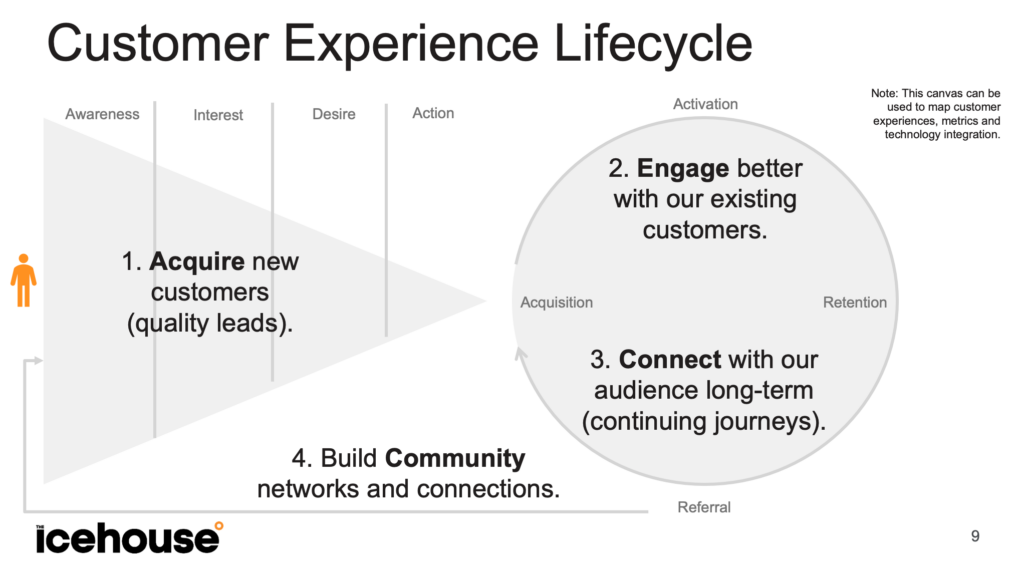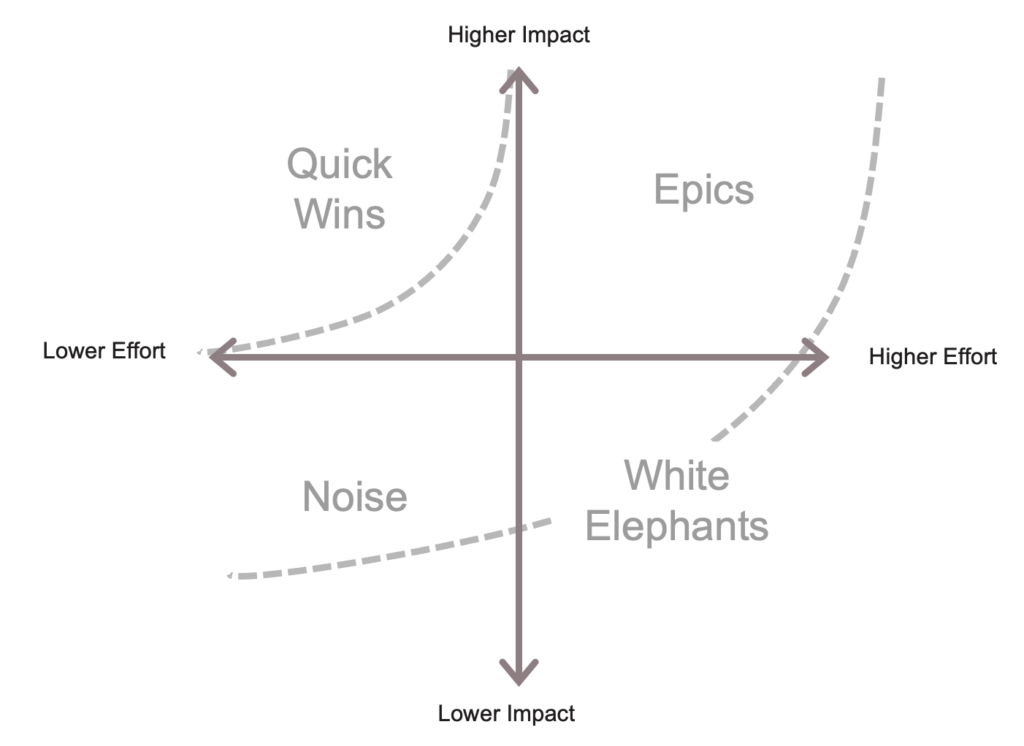I spend most of my time at the coal face of new product development inside tech startups. But I’m occasionally called on to help with the broader application of technology throughout a medium-sized or larger organisation. I love seeing how improving their digital tools and systems can make an entire organisation more customer focussed.
Some digital projects only impact one part of the overall customer experience, but these days, any good software project should really consider the wider context of the entire organisation and the whole customer experience that they deliver.
Different company sizes approach digital transformation differently
I’ve noticed that digital transformation projects can be very different in a small to medium sized organisation. Corporates, startups and mid-sized SMEs handle digital transformation and customer experience innovation very differently:
- In a corporate there are whole teams dedicated to technology and the connections between functional departments. While there is a lot of bureaucracy, digital transformation and customer experience projects are feasible inside a corporate because they can throw resources at a problem.
- In a small business or startup, the whole team is closely enough connected that cross-functional collaboration is inevitable. While resource constrained, the ability to implement change quickly makes startups fast to adapt to changing circumstances and customer needs. They also often have the advantage of dedicated internal software developers, digital marketers and operations specialists with deep technical systems experience.
- Good honest medium-sized SME businesses can be the teenagers of adopting digital technology. Big enough to have departments with competing goals and seperate tech systems. But small enough to be resourced starved and unable to invest in major organisational change projects. Digital transformation is hard for SMEs.
Icehouse Ventures is a small, independent rogue team that spun out separately from the Icehouse several years ago. I’m now the CTO of that business and we effectively operate as a tech startup ourselves with dedicated marketing, operations and software development capability. But it wasn’t always like that. And the wider Icehouse (in particular the SME learning & development business) has been through a genuine company-wide digital transformation over the last two to five years. There are several lessons that we’ve learned at the Icehouse in pursuing our own digital transformation and in helping other medium-sized New Zealand businesses with adopting digital technologies better across their whole business.
Digital technology maturity scale
Digital transformation is simply a description of the broad adoption of digital technologies throughout a business. Digital transformation is best measured by how connected together a customer’s experience is with the business. There are several levels of maturity in a company’s gradual digital transformation:
- Disconnected Experiences: At level one, every business system is separate and siloed (or possibly offline entirely). For example, it’s annoying for customers when a store’s e-commerce website can’t show whether a particular branch has stock on a particular product because the stock management system doesn’t talk to the website CMS. Or when you lose your receipt for a warranty claim and the loyalty card system won’t talk to the warranty claim software.
- Connected Experiences: At level two, a company’s various internal systems are separate but are starting to be connected by syncing tools and APIs. This starts to allow for more connected experiences. For example, an e-commerce order can be re-routed easily to in-store click & collect. Or a forgotten loyalty card can be easily looked up using a phone number.
- Seamless Experiences: At level three, a company’s systems are so well integrated that they can be navigated by the customer just as easily as internal staff. At this level we see self-service customer portals, hybrid in-store and on-line checkouts, and in-store payments collected by a self-service mobile app.
Customer Experience Canvas
The tool I used to map and diagnose digital customer experiences throughout the full customer lifecycle is the Customer Experience Canvas. The CX Canvas combines a pretty standard marketing funnel (based on the AIDA model of awareness, interest, desire and action) with a CX Flywheel (similar to the one proposed by HubSpot with stages for acquisition, activation, retention and referral).

There are several potential layers to the canvas depending on the project and intended application:
- Experience: The surface layer of the funnel and circle can be used to map the digital touchpoints a customer interacts with throughout their experience of your product. Making these experiences more connected and efficient is a key part of digital transformation.
- Data: The same canvas can be used at a deeper level to map out the data used to measure and track the experiences. The metrics we use across the whole lifecycle are based on Dave Mclure’s ‘pirate metrics’ (so called because the acronym is AARRR): Acquisition, Activation, Revenue, Retention and Referral.
- Technology: Even deeper, the canvas can be used to map the technology stack and systems integration work required to deliver a seamlessly connected customer experience. This layer looks at the syncing tools, triggers & events and APIs needed to make the whole system work together.
Agile Project Prioritisation Matrix
In 2001, as a reaction to traditional engineering project management techniques (that had been optimised for construction projects), a group of software developers proposed the ‘agile manifesto’. This approach to software development prioritises speed, simplicity and efficiency. There are lots of tools and techniques from agile that can be applied to an organisation wide push for digital transformation.
I’ve found that most companies undertaking digital transformation end up with a giant todo list and no practical ways to have shared conversations about prioritisation. One of the best tools to reach agreement on prioritisation is the Agile Prioritisation Matrix.

When considering a whole of company digital transformation it can be an overwhelming task and it’s hard to know where to start. The agile project prioritisation matrix breaks projects down by:
- Impact: Potential return on investment, improvement in customer experience, etc
- Effort: Likely expense, time and complexity of implementation.
Projects that are high impact and low effort are quick wins and should be done first to build momentum. High impact and high effort projects are called ‘epics’ and are important to tackle but take time to finish. Whether easy or hard, lower impact projects should be avoided where possible.
Digital Transformation Checklist
Having mapped the customer experience and prioritised the key projects, it’s also worth checking that you have all your basic tools in order so nothing gets lost. Boiling all the strategy down, I’d still suggest checking these basics are in place:
- Marketing: Website Analytics & Email Newsletter metrics.
- Sales: Customer Relationship Management System.
- Production: Invoicing, production and shipping software.
- Service: Customer Feedback System such as NPS surveys.
- Operations: File storage, knowledge management and internal instant messaging.
Across all of these, it’s essential that your CRM can act as more than just a sales tool and provides enough APIs and/or syncing tools to eventually act as a centralised customer data platform. Because in the end, having your customer data centralised in one place is the most important part of providing a seamless digital customer experience.
You can learn more about digital transformation in a podcast I did with Bryar Stewart from the Icehouse team:

